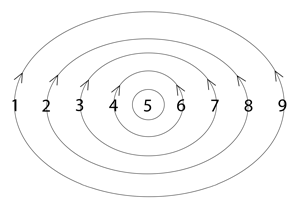imagination
8-5-4
Conventional Understanding
We usually think of imagination as creating mental pictures of things that aren’t really there. “It’s just your imagination” is our way of saying something isn’t real. Schools treat imagination as nice for art class but not much else. This limited view treats imagination as separate from reality—just fantasy happening in our heads.
Resonant Understanding
Word Cosmology reveals “imagination” shares the same pattern (8-5-4) as “resonance” and “two-way motion.” This suggests imagination isn’t about making things up—it’s about tuning into patterns that already exist.
Think of a radio. It doesn’t create music; it picks up signals that are already in the air. Similarly, imagination doesn’t create reality but helps us recognize patterns we might otherwise miss.
Expressions Spectrum Analysis
When in balance, imagination shows up as “conscious intention,” “connection,” and “revelation.” It helps us spot patterns beyond what our senses directly perceive. Like a good conversation that flows effortlessly, balanced imagination connects us with what’s actually present without forcing or straining.
When over-modulated, imagination becomes “I am the force,” “claim the experience,” and “rational mind.” It tries to control what patterns are allowed to appear. It’s like wearing sunglasses indoors—you’re deliberately filtering what you can see.
When under-modulated, imagination appears as “automatic pilot,” “compromised,” and “I fear my location.” It can’t form clear pictures of what’s happening. Like a radio with poor reception, it picks up mostly static.
The pattern also appears in expressions like “undivided light” and “sequential unfolding of idea,” suggesting deeper connections to how we perceive reality itself.
Russell’s Cosmogony Connection
Walter Russell’s understanding helps explain imagination’s true nature. He writes:
“This universe… consists of motion only. Motion simulates substance… which deceive the senses into seeing substance where motion alone is.”
This connects to why “imagination” shares patterns with “two-way motion.” What seems solid is actually patterns of motion—patterns imagination helps us recognize.
It’s like how certain piano strings vibrate when their matching note is played nearby. They’re not creating the sound but responding to it. Similarly, imagination doesn’t create reality but responds to patterns already present.
Practical Implications
This changes how we approach imagination. Rather than seeing it as making things up, we can recognize it as spotting patterns others might miss.
Instead of forcing creativity, we might practice becoming more sensitive to patterns that are already there. The most creative people aren’t inventing reality—they’re noticing patterns others overlook.
This challenges how we think about imagination in education and business. By recognizing imagination as pattern-spotting rather than fantasy-making, we open ourselves to a more authentic creative process—one that connects with universal patterns rather than trying to invent reality from scratch.
Walter Russell’s quotes are from his book, “A New Concept of the Universe”.
Related Words:
No results found.


